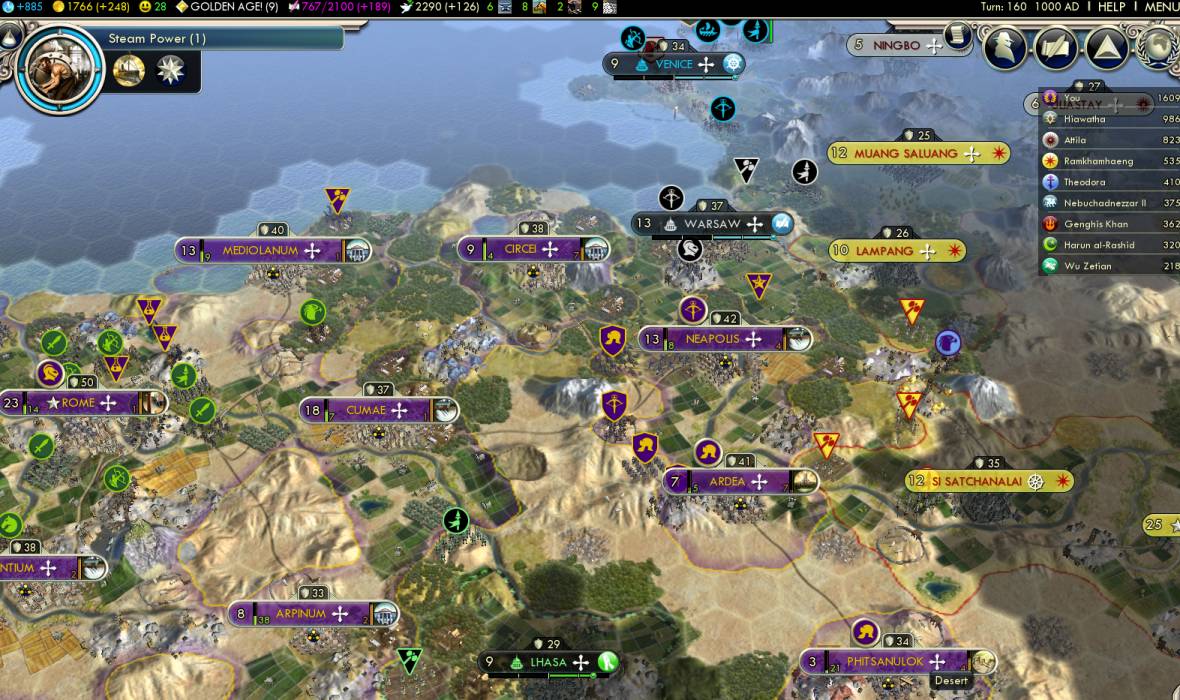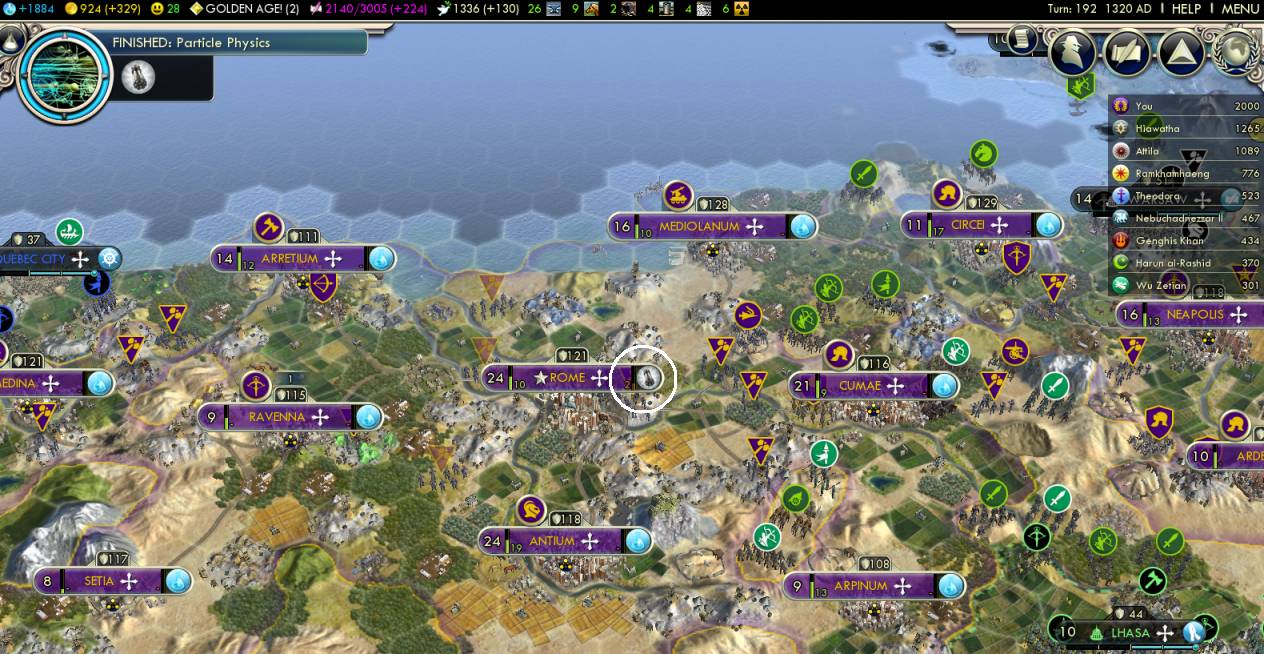

Here's the traditional 1000 AD overview, in the traditional two parts because Civ 5 is untraditional and can't zoom out. That's 13 native cities and one puppet. Yeah, that's an incredibly late Colossus in Arretium, just because three four city-states wanted it.
The cities built along standard lines, prioritizing research, usually going granary - monument - aqueduct - library - university - public school. It was hard to judge exactly how helpful Rome's ability was here, but just in general it should develop a city 25% faster, getting all these buildings done in say 64 turns instead of 80. (I'm not quite sure if the accelerated early buildings come out ahead of 25%, or if diminished efficiency on the expensive buildings make the ultimate benefit less than 25%.) Rome city bought most of its later buildings to enable the UA right away for others. I later added workshops, hydro plants, factories in most cities. Also judiciously bought Pagodas in cities that needed culture quickly.
A number of city-state quests followed, with me ending up allied with most of the CS as usual. It's kind of embarrassing how easy it can be to rack up a whole slate of allied CS, just by satisfying random demands for wonders and resources and natural wonders. Spies helped too; I got lucky when one spy on defense killed two enemies in the same turn, giving me a Special Agent who went on to stage several coups to swipe CSes. (BTW, micromanagement note, keep track of the city-state election cycle. 5 turns before each election, move all the spies to CSes, because that's how long they take to establish operations. After each election, they can go bother somebody else before returning to the CSes. Don't leave a spy idle when it's 14 turns to the next election.)

I inadvertently got the 500-faith Prophet, thanks to reaching 505 faith one turn before the industrial age. My neighbors had all been converted by missionaries. So I sailed him over to the Iroquois. It's rather weird that the efficiency of religious spreading mostly depends on the density of small cities, how many cities fit within each city's 10-radius pressure range and convert quickly. Hiawatha had built quite densely as you see. So this one single Prophet who converted four cities then turned into nearly 20 Christian cities and thus CB happiness.
I had two rounds of Research Agreements in the game. The first set of four matured in the 130s for Architecture, Economics, Sci Theory at about 700 beakers per RA. The second set came in the 160s awarding techs in the lines up to Plastics. I could then see a third set wouldn't complete before the game would. This is something that can be managed more precisely for speed science. Either you should get Education by about turn 95 in order to cycle through three waves of RAs before turn 190, or else you can put off Education until around 125, settle for only two RA waves, and avoid spending money on early fairly weak RAs.
In the social policy department, the alpha and omega was Rationalism. I had to push culture a little bit building some amphitheaters, but the tree finished nicely on time.
The Great Person department went like this: Naturally spawned scientists at 100 and 200. Pisa Tower for the 300 slot. Porcelain Tower for the 400 slot. Natural GSci and GEng together at 500. Then two from Hubble Space Telescope and three from faith, making 10 Great Scientists in all (9 for bulbing), and the one Engineer who went for Hubble.
The shot above shows 40 excess happiness. I should have gone conquering to turn that happy into productive cities and beakers, but somehow it just didn't occur to me. I had a dozen units from militaristic city-states but never used them. In my mind, I'd just already made peace with Arabia and Siam and so war with them was no longer an issue.
But I put the happy to use elsewhere. This is something I haven't done before, but I started even building more happy just to reach the second happiness Golden Age. Each surplus happy-turn represented 1/850 of that Golden Age. The value of a GA would be 20% of 300 MFG x 15 turns = 900 hammers total, and about 1500 gold too. This means each happy-turn was roughly worth one hammer and two gold, which meant it was correct to buy luxuries and not sell them. Likewise, $250 to a city-state for 20/.75 = 26 turns of a happy resource was worth it, that would represent 104/845 of the $1500 Golden Age, almost paying back for the entire investment in gold and exceeding it in figuring hammers too.
I built fairly few later wonders, Statue of Liberty, and Hubble of course. Skipped Eiffel Tower, 1000 hammers / 10 happy was a worse ratio than theaters (especially considering the Rome UA discount on the mundane building.) Skipped Sydney Opera House, didn't really need any other policies, and my coastal city didn't have enough hammers for it anyway. Skipped Big Ben, just didn't have time, as with Kremlin and Neuschwanstein and the rest of the military stuff.
Some cities built Research Labs quickly, some slowly, some had them bought, and about a third never got them. This feels wrong, but it's right. I learned this over a few runs at transcendence speed in Alpha Centauri. My vision and earlier attempts in both titles had been of a nice organized square build, with all the cities building research multipliers and factories and everything in nicely choreographed lockstep. But that's wrong. You don't want organized, you want the ragged edges. If every city were to finish its research lab promptly... that means the civ didn't push hard enough on more cities. You SHOULD expand to the point where the last cities are marginally viable. Fast is chaotic.
Although in Civ 5 you have to stay wary of inflating policy costs, so maximum ICS is not correct for science. Rationalism must be finished, no amount of fringe cities will make up the 20k beaker value of the two free techs. So just like the correct wideness for culture is exactly enough research to make Sydney Opera House, the correct wideness for science is whatever will still reach the Rationalism finisher. I got it mostly right here, perhaps could have been a city or two wider with more emphasis on amphitheaters and artists, or more if I'd somehow aimed a Great Engineer for SOH.
Anyway, the important thrust of the late game management was how to schedule the lightbulbs, to avoid Korea's situation of overshooting by 72,000 beakers. It went like this. Mostly I didn't directly bulb the techs mentioned, but rather bulbed slightly ahead of time such that the overflow would bring the desired tech to one turn from completion. That would make sure each turn-end produced a tech instead of stacking up too much overflow.
That was mostly right. I was really worried about overwaiting and overshooting on the bulbs, so conservatively erred on the side of early this time. It may have been about four turns away from optimal but no more. The only thing that went wrong is that I built Hubble too soon. It should have waited five turns, in order for a city to pop the 700-point Great Scientist before Hubble's free ones pushed the cost beyond the event horizon.
A significant difference between this Rome and that Korea was that Rome's beaker production topped out significantly behind, only 1800 compared to 2600. So each late bulb reached less far than I'd anticipated. (That differential happened because Korea had added more cities with a midgame conquest, and of course their specialist UA.) But all in all, Rome did perform as I'd expected, getting the public schools and research labs up significantly quicker so that bulbs could be fired sooner.

I did set up to build that last SS part (at Particle Physics) completely correctly. I prepared Rome early enough, mining its farmed hills, bought its solar plant, and set up a good overflow chain to dump three turns worth of overflow hammers into the build. So Rome finished the last part in just two turns, much better than the nine that Korea took after the last tech.
Science Victory at turn 194 1340 AD.

Wow, check out how linear that science graph is. Nothing like you see in Civ 4 with hockey-stick exponentiality as cottages multiply with buildings multiply with corporate-food specialists. That actually makes me feel pretty good that even my slightly-early bulbs went for at least 75% of terminal value, so not much time lost there. So I can be satisfied with this result.
I plan to close the books on my Gods & Kings reporting here, with no more game plans in mind. I may see you again if something in particular does inspire me, or else on the flip side in a Brave New World.